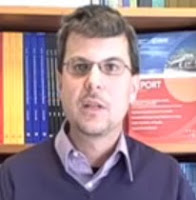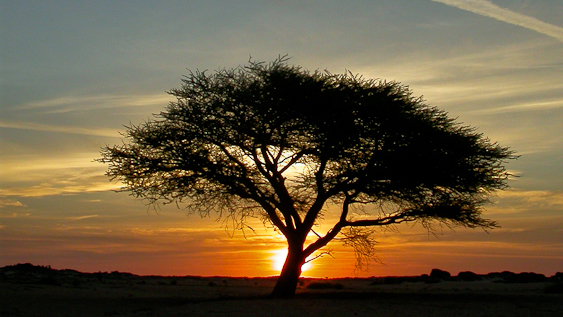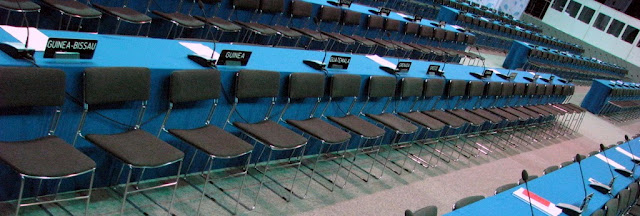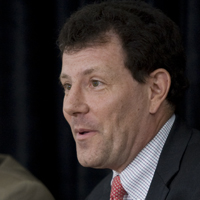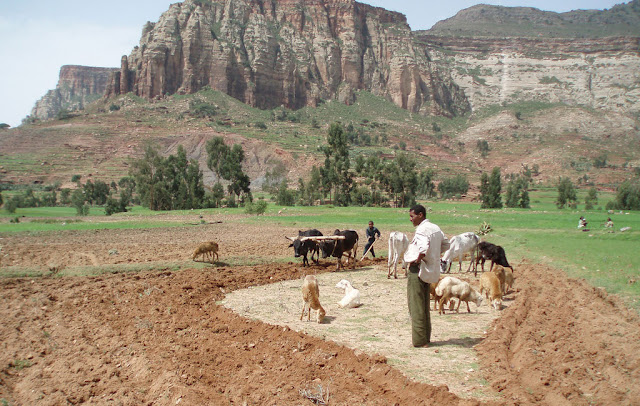Showing posts from category foreign policy.
-
Energy and Climate Change in the Context of National Security
›“Climate Change and Security,” a short briefing by Paul Rogers of the Oxford Research Group, examines the recent trend of framing climate change in terms of a national security threat and presents some of the pros and cons of this viewpoint. Rogers says the recent uptick in interest by the military is expected – and welcomed – because military planners often perform more long-term analyses than other policymakers. However, Rogers also cautions that the military, in its role as protector of the state, will naturally focus on adapting to the effects of climate change rather than preventing them. Thus, while this willingness to think long-term is appreciated, work remains to convince the international security community of the importance of carbon-cutting measures as well.
“Fueling the Future Force: Preparing the Department of Defense for a Post-Petroleum Era,” by Christine Parthemore and John Nagl of CNAS, is a comprehensive policy paper arguing for the U.S. military to aim for the ability to operate all its systems on non-petroleum fuels by 2040. Parthemore and Nagl outline a broad set of recommendations that address DOD’s consumption habits, leadership structure, finances, acquisition process, and mission goals. Notable, in the context of Paul Rogers’ warning, is that the authors’ argument is essentially one of supply and demand, rather than for cutting emissions to reduce the effects of climate change: “…while many of today’s weapons and transportation systems are unlikely to change dramatically or be replaced for decades, the petroleum needed to operate DOD assets may not remain affordable, or even reliably available, for the lifespans of these systems.” -
Christian Leuprecht on Demography, Conflict, and Sub-National Security
› “Demographics are going to be to the 21st century what class cleavages were to the 19th century,” said Christian Leuprecht in this conversation with the Environmental Change and Security Program. Leuprecht is an assistant professor at the Royal Military College of Canada and was one of the authors featured in ECSP Report 13.
“Demographics are going to be to the 21st century what class cleavages were to the 19th century,” said Christian Leuprecht in this conversation with the Environmental Change and Security Program. Leuprecht is an assistant professor at the Royal Military College of Canada and was one of the authors featured in ECSP Report 13.
“Specifically with regards to demography and security, the challenge that I see is at the sub-national level. That is to say that most of the conflict, if you look around the world – the intractable conflicts, the violent conflicts, the conflicts that have been dragging on for decades – tend to be at the sub-national level,” he said. “Yet much of the academic work and the way data are gathered are at the national level.”
The “Pop Audio” series offers brief clips from ECSP’s conversations with experts around the world, sharing analysis and promoting dialogue on population-related issues. Also available on iTunes. -
Watch: Population, Health, and Environment in Ethiopia
›Severely eroded and deforested, Ethiopia’s land is increasingly turning to desert, due to the country’s high population growth, unsustainable land use, and lack of land ownership. Featuring footage from my trip to Ethiopia last year, this video looks at the efforts of two projects to combat these devastating trends by meeting the country’s complex challenges with integrated solutions.
Ethiopia’s population is estimated at 85 million. Since 1900, the country has grown by nearly 74 million people, and the United Nations predicts this rapid growth will continue, reaching nearly 120 million people by 2025.
“Family planning is very crucial” to sustainable development, said Gebrehiwot Hailu of the Relief Society of Tigray (REST), located in the northern region of Tigray. “If the family has more children… he can’t feed them properly, he can’t send the children to school, because there is a food gap in the household.” REST uses a watershed planning model jointly developed by the community, health workers, and government agencies.
Realizing there is no silver bullet to development, projects like REST integrate population, health, and environment (PHE) programs to engage these challenges from all angles.
The Ethio Wetlands and Natural Resource Association (EWNRA), located in Ethiopia’s Wichi watershed, uses a combination of techniques to restore the watershed, create alternative livelihoods, strengthen health systems, and improve reproductive health.
“Through this integrated watershed intervention, the wetland is regaining its natural situation,” Shewaye Deribe of EWNRA told me. “The communities with their own bylaws, with their own watershed committee, with their own organization… are protecting these remaining forest patches.”
Sources: Population Reference Bureau. -
Youth on Fire at UN Climate Talks in Tianjin
›For the past week, as part of the Adopt a Negotiator program, I got the chance to observe many of the negotiations of the latest UN Framework Convention on Climate Change (UNFCCC) intersessional meeting that took place in Tianjin, China. In many ways it was rather humdrum. I observed as negotiators debated changing agendas and the mandate of contact groups rather than the issues themselves, and made many of the same, tired position speeches again and gain.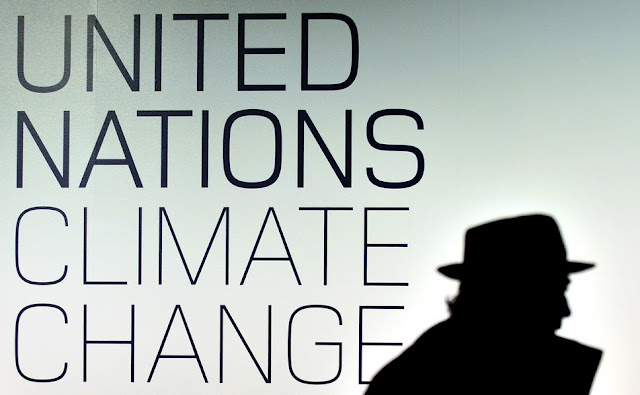
When controversial issues did rise to the fore, they felt like more of the same old, same old: arguments between China and the United States about who is doing more to stall the talks and who should make legally binding emissions cuts; developed countries carving enormous loopholes into the LULUCF; the greenhouse gas inventory sector covering emissions and removals of greenhouse gases resulting from land use. But the dry nature of the talks concealed the more important truth – that the negotiators are not just discussing acronyms, but human lives, which could be catastrophically altered due to the effects of climate change.
The Adopt a Negotiator program is supported by the Global Campaign for Climate Action, a group of young people from countries around the world who come to the UNFCCC meetings to track the delegations from their own countries and share what is happening at the negotiations through social networking tools (be sure to check out our blogs).
If the UN climate talks fail, and if countries cannot muster the political will to make substantial economy-wide changes and greenhouse gas emissions continue unabated, the results for the poorest and most vulnerable people on the planet will be catastrophic.
Last week was the first time that I have ever experienced any kind of UN negotiation first hand, and some of what I saw was incredibly depressing. Mitigation efforts are especially in danger, as disagreements primarily between the United States and China about who should agree to emissions cuts and international reporting and verification requirements sharpened and intensified.
But there were many bright spots as well. Negotiators are very close to making the final decisions about an international architecture for technology transfer to help the most vulnerable and poorest countries adapt to the effects of climate change and mitigate greenhouse gas emissions. They also spent the week narrowing and refining draft text with regards to climate finance and an international architecture to disburse “Green Funds,” and hopefully will be able to make final decisions at COP-16 in Cancun this November 29th through December 10th. These steps are small examples of potential good news for the people who will suffer, and are most likely already suffering, from climate change’s global impacts.
Unfortunately, negotiators are already in agreement that the only bright spots that we are likely to see at COP-16 are small items such as these. Almost no one believes that there is any chance that countries will agree on a final, legally binding text to reduce carbon emissions, and negotiators have instead pushed off this decision until the next Conference of the Parties (COP) in South Africa in 2011. Instead, the near-universal buzz at the conference was about a “balanced package.” Although the phrase in reality means something slightly different to everyone who uses it, it is generally understood to refer to a set of decisions on issues like climate finance, technology transfer, initiatives to cut back on deforestation, and putting some of the decisions made under the Copenhagen Accord into legally binding text, like “fast start” finance measures to the developing world.
In many ways the Tianjin session was itself a “balanced package” – a set of interactions and experiences that was both deeply discouraging and incredibly uplifting. One of the personally uplifting moments for me was having the honor of delivering a short intervention on the first day of the opening plenary on behalf of youth NGOs around the world (known as YOUNGOs). In the words I read, which had been drafted by a group of Chinese youth, all the particulars of policy were stripped away and the only thing that remained was the frustration – and also the hopes – of young people around the world (those who will actually experience the effects of climate change well within their lifetimes if UNFCCC negotiators don’t work harder to reach a consensus).
Through the disappointments of Copenhagen to the slow-moving intersessionals throughout this year, many pundits have cynically declared the UNFCCC process dead. This is certainly not the case. But if they are truly serious about saving the planet from climate change’s most serious impacts, negotiators will certainly have to work harder in Cancun.
Alex Stark is a Program Assistant at the Friends Committee on National Legislation, working on the Peaceful Prevention of Deadly Conflict Program. She attended the Tianjin negotiations as part of the Adopt a Negotiator team.
Photo Credit: Adapted from “COP11_lo,” courtesy of Neil Palmer and flickr user CIAT – International Center for Tropical Agricultu. -
Tracking the End Game: Sudan’s Comprehensive Peace Agreement
›
The next nine months are critical for Sudan. The 2005 Comprehensive Peace Agreement (CPA) sets January 9, 2011, as the date when southern Sudanese will vote on secession or unity, and the people of disputed Abeyei will vote on whether to be part of North or South Sudan. Between now and July 2011, when the provisions of the CPA come to an end, we could see the birth of the new country of South Sudan—or a return to a North-South war if the referendum is stalled, botched, or disputed. (Few currently expect that a unity vote will create the “New Sudan” envisioned by the late John Garang.)
-
Youth Delegation Makes a Splash at UNFCCC
›October 11, 2010 // By Wilson Center Staff This weekend wrapped up an intercessional meeting of the UN Framework Convention on Climate Change (UNFCCC) in Tianjin, China – one of the last before this December’s big follow-up to Copenhagen in Cancun (COP-16).
This weekend wrapped up an intercessional meeting of the UN Framework Convention on Climate Change (UNFCCC) in Tianjin, China – one of the last before this December’s big follow-up to Copenhagen in Cancun (COP-16).
Alex Starks, formerly of CNAS’s Natural Security and now shadowing the U.S. climate delegation with the Adopt a Negotiator Project, got a chance to make a brief speech on behalf of a coalition of youth-orientated NGOs, and according to onlookers the speech made quite a stir amongst the assembly. Karl Burkart of tcktcktck.org wrote:Normally these 2 minute NGO speeches are politely tolerated by UN negotiators waiting to get on with the day’s business, but in this case Alex’s talk had ripple effects. The LCA (Long-term Cooperative Agreement) chair took the time to formally comment on her remarks, and later in the day the chief EU negotiator said, “If you need a reminder about what we’re up against, listen to the youth delegate’s statement.”
The full text of Alex’s speech is worth a read. Stay tuned for more on the UNFCCC and the lead-up to Cancun, as Alex has promised a guest contribution to The New Security Beat in the coming days!
Photo Credit: Adapted from “IMG_2474,” courtesy of flickr user benkamorvan. -
Nicholas Kristof on Maternal Health Challenges and Opportunities
› After a Wilson Center Global Health Initiative event last year, New York Times columnist Nicholas Kristof spoke with ECSP Director Geoff Dabelko about the importance of maternal health issues and what can be done about it.
After a Wilson Center Global Health Initiative event last year, New York Times columnist Nicholas Kristof spoke with ECSP Director Geoff Dabelko about the importance of maternal health issues and what can be done about it.
“You just know that if men had uteruses and were dying at this rate, every country would have a Minister of Paternal Mortality, the Security Council would be meeting…this would be a real international priority,” said Kristof. “It just should not happen that one woman dies a minute for reproducing.” He recently revisited this topic with a column titled, “Birth Control Over Baldness.”
The “Pop Audio” series offers brief clips from ECSP’s conversations with experts around the world, sharing analysis and promoting dialogue on population-related issues. Also available on iTunes. -
Ethiopian Case Study Illustrates Shortcomings of “Land Grab” Debate
›The lines have been drawn in the “land grab” debate: Will foreign investors displace small, local land-holders, damaging the environment with exploitive practices? Or will a combination of infrastructure investment and employment opportunities lead to a virtuous development cycle?
Recent reports suggest that the former is more likely than the latter (e.g., see the Oakland Institute, GRAIN, and the Food and Agriculture Organization). In each case, the proposed antidote is the typical wish-list: Boost institutional capacity to ensure that agreements are honored, environmental and labor regulations are observed, and local populations are given a stake in the process.
While it incorporates a broader swath of data and country case studies, the recent World Bank report, “Rising Global Interest in Farmland: Can It Yield Sustainable and Equitable Results?” largely recycles this tired diagnosis, as noted recently by Michael Kugelman on The New Security Beat.
But the two months we spent in the Amhara and Oromia regions of Ethiopia, surveying smallholders and profiling large-scale commercial farms, left us with a different impression. After completing 1,200 pages of surveys on smallholder livelihood strategies and farm management practices with 120 local farmers, as well as six profiles of private investors’ farms, we identified several key points that these reports missed.
Strong Laws Don’t Always Scare Investors Away
The World Bank report focuses on the belief that countries with weak institutions attract predatory investors, who use lack of oversight to their advantage by exploiting local populations, abusing regulations, etc. Ethiopia, however, has high institutional capacity relative to other African nations, yet still receives enormous land investment.
Every commercial farm we profiled received yearly visits from multiple regional and federal agencies investigating regulatory compliance. Moreover, two of the farms had been sold to their current owners because the previous business ventures failed to observe the terms of their business proposals. These terms included bringing certain amounts of foreign exchange into the country and hitting export targets.
Ethiopia attracts investors for other reasons. Official documents tout the diversity of its micro-climates, but we suspect investors are more likely drawn by a lease rate roughly 100x lower per hectare than the African average.
Given the emphasis on boosting institutional capacity as a means to ensure positive development outcomes, it’s too bad that the World Bank didn’t choose to conduct one of its case studies on Ethiopian commercial farms. Such a study could provide grounds for discussing what investment governed by stronger institutions would look like.
An Incomplete Paradigm
The potential for population displacement (with or without compensation), job creation, and infrastructure development is a well known and well studied paradigm. The World Bank report investigates the occurrence of these phenomena in its case studies, and the results are unsurprising: Sometimes things go OK and sometimes they go badly. This same story emerges in studies of foreign investments of all stripes: logging, oil and natural gas extraction, precious mineral mining, among others.
A more inventive analysis of land grabs could yield meaningful findings, however. Investors and smallholders are engaged in the same activity — farming — and in the case of cereal farms, they are producing the same crops. The resulting overlap allows for a multitude of creative interactions between smallholders and investors that should receive more attention.
Two of the investors we interviewed used these creative interactions to promote their business plans to regional development authorities. One farm sold certified seed to local farmers; another imported an irrigation system new to the region and plans to introduce it to the broader community. They each rented farm equipment to smallholders and held demonstration days to discuss farming techniques and new crop types with community members. One had already introduced new crops to the adjacent village via an “outgrowing” scheme and was exporting smallholder products from the farm, thus diversifying livelihoods for local farming households.
These are, of course, anecdotal accounts. But they suggest a broader point: More attention must be given to “secondary” benefits like technology and knowledge transfers, outgrowing or renting schemes, and informal interactions. Given the unique attributes of large-scale commercial investment in the agricultural sector, which continues to provide most Ethiopians’ livelihoods, these secondary benefits are the mechanism through which livelihoods seem most likely to be transformed. In this case, the preoccupation with displacement, formal compensation, jobs created, and infrastructure development only leads to generalized and ineffective analysis.
Our smallholder surveys and commercial farm profiles point to one conclusion: The commercial farms in our sample that engaged most fully in those creative interactions will generate substantial benefits for local populations over the next 5-10 years (quantitative analysis to be published in our final report this spring). The particular interactions taking place between these smallholders and commercial farms directly alleviate the primary constraints to smallholder livelihoods identified by our survey, such as lack of mechanization, lack of access to inputs, and inability to generate cash through sale of crops.
It’s far from clear that the World Bank analysis would have captured this reality in Ethiopia given its limited focus. Ideas like outgrowing receive scant attention, and are usually only discussed in hypothetical terms or in parentheticals – a trend the World Bank report unfortunately continued.
Incorporate Case Studies and Put Livelihoods First
So while our limited analysis may not enable us to speak broadly about the effects of commercial farming, we can offer two observations.
First, the creative arrangements that accompany the introduction of commercial farming must be front and center of any study. The study should be grounded in an understanding of the livelihood constraints faced by local populations, followed by an analysis of the types of interactions between commercial farms and smallholders that may affect those constraints, including not only traditional effects, such as displacement and employment, but also atypical impacts, such as improved seed distribution and technology demonstration.
Second, since Ethiopia has enough institutional capacity to be selective when choosing commercial investors (and to ensure they adhere to the terms), it embodies a number of principles the promoted by the World Bank report. Ethiopian Prime Minister Meles Zenawi views large-scale private farms as one piece of a broader commercialization effort to revolutionize smallholder agriculture, as described in the government’s development plan, PASDEP. This effort is in keeping with the report’s basic recommendation that host governments ensure that investment is compatible with domestic needs.
Understanding the phenomenon of large-scale land acquisitions should be at the top of the international research agenda. The effects on livelihood security and food security (in both developed and developing countries), as well as the potential contributions to resource conflicts, place such land deals among the most consequential recent trends in the international arena.
We believe a new framework must be brought to the analysis of land grabs. To effectively implement this framework, important but overlooked cases, such as we found in Ethiopia, should be included in future studies.
Nathan Yaffe and Laura Dismore are students at Carleton College, who just returned from researching commercial farming in Ethiopia. They can be reached at yaffen@carleton.edu and dismorel@carleton.edu.
Photo Credit: Adapted from “P8060261,” courtesy of flickr user Ben Jarman.




